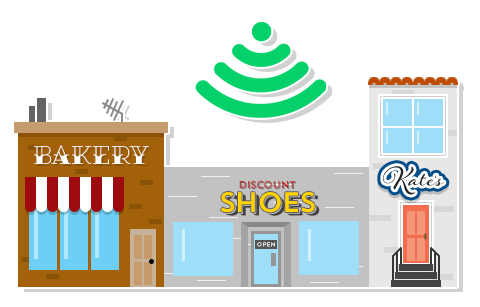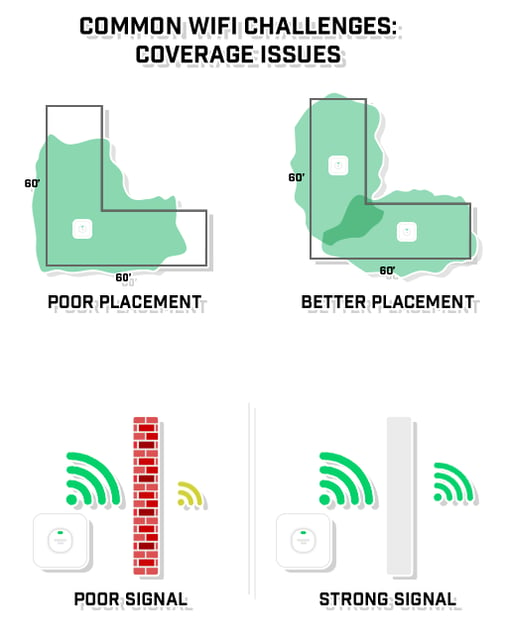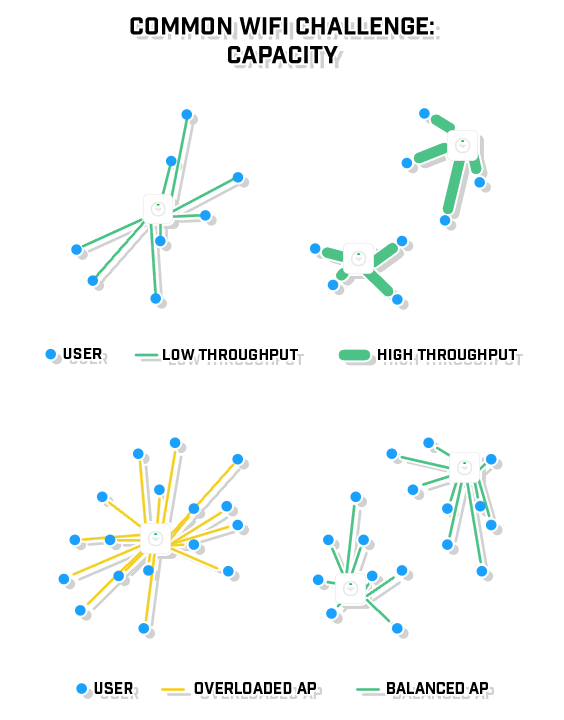WiFi has taken over our homes, our schools, and our workplaces. It seems only fitting that it would also play a major role in other places where we spend our time. Retail environments have become quite dependent on WiFi for both consumers and workers.

Retail WiFi has forever changed the consumer game. By deploying WiFi in commercial retail spaces, consumers can stay online while shopping, comparing prices, navigating the store, and even checking inventory. But it’s not just consumers who have benefited from the emergence of retail WiFi. Employees and operations management are able to collaborate and communicate seamlessly while instantly updating inventories and dispatching work orders.
Common Challenges
Despite becoming more and more commonplace, implementing retail WiFi still poses certain challenges. These challenges can arise from poor planning and implementation of the network.
- Coverage – Without properly planning for the amount of access points (AP) needed or where they should be installed, the coverage in a retail environment can suffer greatly. Moreover, it is imperative that the building materials, furniture, ceiling height, and storage spaces are also taken into consideration as they can weaken and impede a network’s coverage and connectivity.

- Capacity – Figuring out the capacity needs for a retail space is one of the biggest challenges of all since people are floating in and out every few minutes. It is impossible to know how many people will be in and how much data will be traveling through the space at any given time. More data will mean more stress on the network, so it is important to plan for the total amount of throughput.

- Compatibility – Technology is constantly changing, creating an ever-growing backlog of legacy devices. Inventory scanners and P.O.S. devices are expensive and it makes no sense to be constantly upgrading them just because upgrades are available. It is recommended to get as much use out of your current devices as possible until they are no longer compatible with newer network components.
- Confidence – Network confidence means security. Security is a major cornerstone in planning and designing retail networks. The wireless network in a retail environment needs to be completely secure while also authorizing access for numerous devices.
Best Practices
The number one best practice for deploying a wireless network in a retail environment is planning. Preparing for a retail network deployment is very much like planning for any network deployment. The following checklist is chock-full of basic pre-planning requirements.
- Evaluate and anticipate the services you’ll need your network to offer.
- Evaluate and anticipate the application types you’ll be deploying.
- Evaluate the optimal segmentation of data and number of logical networks your setup may need.
- Evaluate the location and architectural parameters.
- Evaluate and anticipate the network’s connection and capacity needs.
- Evaluate and anticipate your network’s compatibility requirements.
- Evaluate and anticipate your security needs.
Types of Retail Spaces
There are several types of retail spaces. While their networks might function similarly, no two are the same. Therefore, during the extensive planning stage, it is necessary to understand that retail WiFi must be completely tailored to the individual space.
- Large Shopping Malls – Most shopping malls will follow a similar set of guidelines when implementing WiFi. However, because of their massive sizes, mega-malls have started using external antennas in order to improve signal range and quality while also limiting co-channel interference.
- Large Supermarkets, Big-Box, and Department Stores – Unlike malls, large supermarkets, big-box stores, and department stores are generally open spaces with little to no dividing walls. Despite being open, they often have rows of racks, exposed pipes and duct work, and countless other possible obstructions that can all wreak havoc on radio frequency (RF) signals.
- Small Retail Shops & Convenience Stores – While smaller shops and convenience stores pale in comparison to the square footage of shopping malls, they do pose their own set of unique situations and solutions. Smaller shops have more flexibility, are able to rely on external resources without threatening security, and can use cloud-based solutions to shift management to a third party.
- Distribution Centers – Because they typically have high ceilings, metal framework, and exposed ducting, distribution center WiFi functions a lot like that of large supermarkets and big-box stores. Directional antennas are recommended for these spaces because they prevent RF leakage and, therefore, help to maintain security.
If you take the time to carefully and thoughtfully plan out and design a network, then you will only have to do it once.



